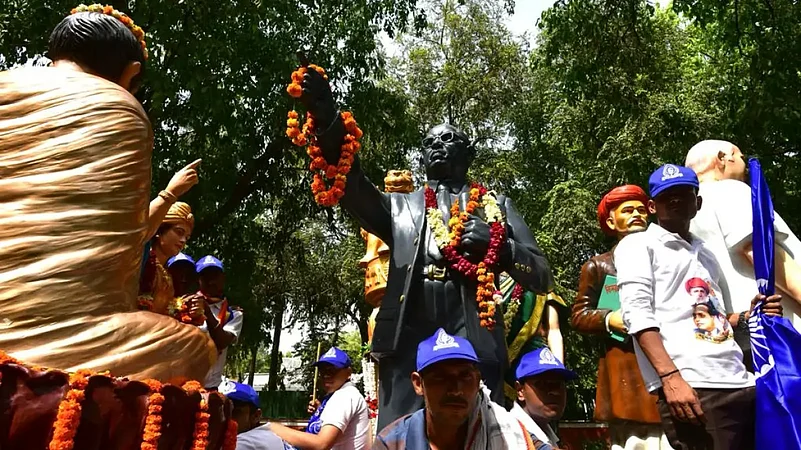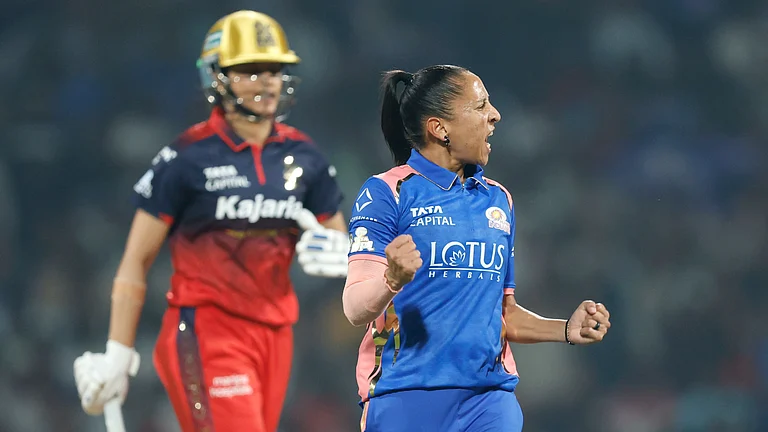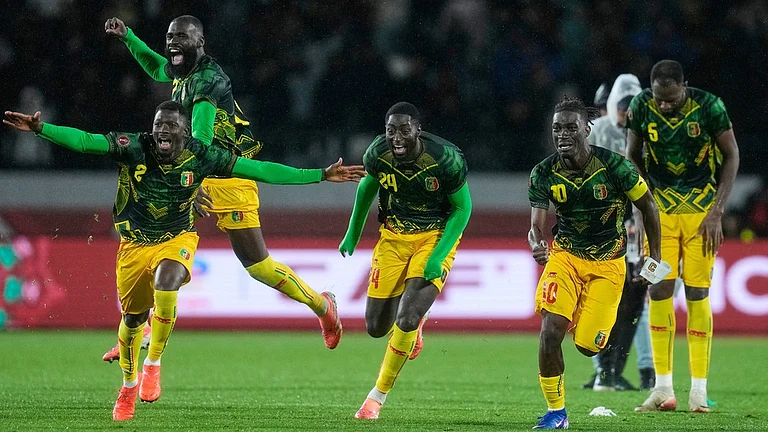Ever since coming to power in 2014, the Bharatiya Janata Party government tried to consolidate the Dalit vote and reverse its upper-caste image by appropriating the legacy of BR Ambedkar. Not only is the party literally cementing its purported ideological proximity to Ambedkar with the polictics of the BJP in brick and mortar but also claiming to be the gatekeepers of Ambedkar's legacy.
In 2017, the PM Modi inaugurated the BR Ambedkar International Centre in Janpath, Delhi. The venue has been used for hosting Azadi Ka Amrit Mahotsav festivities to celebrate India’s 75th Independence Day. In 2018, the PM inaugurate the Dr Ambedkar National Memorial at Alipur Road in New Delhi.
In June 2021, President Ram Nath Kovind, inaugurated the Bharat Ratna Dr. Bhim Rao Ambedkar Memorial and Cultural Centre that the BJP-ruled UP government is building in Lucknow.
Yet another Dr. Babasaheb Ambedkar Memorial, also dubbed as the Statue of Equality is under construction in Mumbai and es expected to be completed by 2023.
The appointment of Kovind, himself from the SC community, was also seen as a way for BJP to appeal to Dalit voters. This year, the party sided with Droupadi Murmu as the first tribal woman to become President of India, indicating political astuteness and perhaps even a true spirit of inclusion.
This symbolism is backed by concerted intellectual efforts to represent Ambedkar as the protector of the Hindutva identity.
The Rashtriya Swayamsevak Sangh, for instance, has long maintained that Ambedkar was pro-Hindutva and shared ties with Hindutva leaders. In a 2020 column for The Print, Arun Aanand, who has written two books on the RSS, claimed that Ambedkar has several links with the Hindu organisation. He spoke of RSS leader Dattopant Thengadi who had allegedly written in one of his books that “Ambedkar told RSS functionaries if they want to unite Hindu society, they should expedite RSS expansion”. The author also claimed that Ambedkar had close ties with RSS ideologues like K.B. Hedgewar and M.S. Golwalkar. The assertions made by Anand and several other members or supporters of RSS or BJP point to a certain ideological sympathy that Ambedkar apparently had for the RSS ideology of Hindu Rashtra.
Such assertions have floated around since the 80s. In the narratives of RSS and its affiliates, Ambedkar is often selectively represented as a “Hindu social reformer” who was opposed to untouchability and shared views sympathetic to those of the RSS toward Muslims.
As per documented evidence, Ambedkar was a staunch critic of Hinduism as well as Islam. He later converted to Buddhism. However, his views on Islam are often inverted and used out of context by the Hindu right wing to project Ambedkar as an “anti-Islam Dalit icon”. Throughout his public life, Ambedkar had been a vehement critic of the Congress and Indian Communists. This fact has also been misappropriated by the RSS to depict him as a supporter of Hindutva.
Ambedkar’s views on the RSS were often published in Janata newspaper, which acted like a mouthpiece for the Ambedkarite movement, as well as his other papers like Bahishkrut Bharat, Janata and Prabuddha Bharat. In a rare reference to RSS, a January 1934 letter authored by Nagpur-based Dalit activist P.D. Shelare critically described the caste segregation in RSS shakhas in Nagpur. There are various other instances of criticism of Hindutva politics in these publications as well as organisations that espoused such views such as the Hindu Mahasabha, which was closely linked to the RSS. Janata editorials and pieces often critiqued Hindutva leaders for their anti-Muslim stance.
While some sections of the RSS claim that Ambedkar was sympathetic toward VD Savarkar, Janata editorials have even panned him. His Patit-Pavan temple built exclusively for the Bahujan community in Ratnagiri was not received well by Dalits, neither was his emphasis on using Sanskritised words in Marathi which critics denounced it as anti-Islamic rhetoric.
In fact, Savarkar and the RSS had been critics of Ambedkar’s conversion to Buddhism in 1965 with the former calling it a “useless act”. Ambedkar was also cliticised by the likes of Hindutva ideologue Shyama Prasad Mukherjee, who was then the law minister, for his attempts to reform Hindu personal laws through the enactment of the Hindu Code Bill in the 1950s.
In recent years, Ambedkar has made it to the list of nationalist leaders honoured by the RSS. He is now often mentioned in laudatory terms in RSS pamphlets and literature. Several RSS-affliated publications like Suruchi Prakashan have brought out volumes like the Manusmriti Aur Dr. Ambedkar (2014), Prakhar Rashtra Bhakt Dr. Bhimrao Ambedkar (2014) and Rashtra-Purush Babasaheb Dr. Bhimrao Ambedkar (2015). These books highlight aspects of Ambedkar’s body of work and thoughts that align with the RSS;s larger ideology by selectively focusing on certain aspects like Ambedkar’s decision to choose Buddhism over Christianity and Islam.
In fact, even his conversion to renounce Hinduism has been subverted to construe that Ambedkar never renounced Hinduism but instead shifted from practicing Vedic Hinduism to non-Vedic Hinduism. VD Savarkar, for instance, called it a change of “sect”, nor conversion of religion.
Despite past differences, the RSS’ attempts to adopt Ambedkarite views and philosophies perhaps reflects the group’s realisation that social inclusion is the key to sustenance in a diverse country like India. It is through the Dalit outreach campaigns and programs of the RSS, the BJP’s ideological parents, that the party was able to make considerable headway in to Uttar Pradesh Scheduled Caste voter base during the February-March Assembly polls. With Dalit-led parties like Mayawati’s Bahujan Samaj Party (BSP) fading, the BJP’s efforts to consolidate the Dalit vote seem to be working. In October, the RSS has plans for a four day summit in Prayagraj to discuss more strategies for Dalit outreach.
The RSS has also been making efforts to woo Pasmanda Muslims that include schedule caste Muslims. Following the party’s by poll win in Rampur and Azamgarh this year, PM Modi himself made appeals to reach out to the Pasmanda Muslim community, making it clear that the BJP is now eyeing to expand its voter base among Muslims as well by using the same formula it used to woo Dalits and OBCs in UP. And the party is not just relying symbolism.
The recent years have seen an increased political representation of Pasmanda Muslims in government offices such as Danish Azad Ansari who was appointed as a minister of state in the UP government. The present chairmen of the state minority commission and madarsa board also being Pasmanda Muslims. Earlier in May, Ansari was called to attend an Eid Milan programme organised by the All India Pasmanda Muslim Mahaz where he spoke about the works being done by the state government. The party also claims that a large number of its welfare schemes in the state are geared toward backward communities and its has found allies among the Pasmandas and Nishads.
Such outreach at the ground level is key to social inclusion and perhaps the reason for the BJP’s political success among Dalit voters despite its ideological differences between the party's philosophy and Ambedkar’s legacy.
And to its’s credit, it seems to have started a trend among its competitors who are now all geared toward their own Dalit outreach policies, AAP being the latest to joit the bandwagon of claimants over the layered and politically loaded legacy of Ambedkar.


























